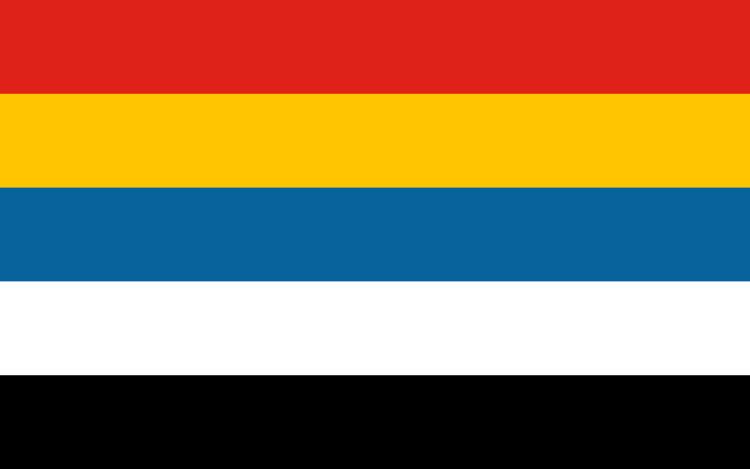Traditional Chinese 五族共和 Wade–Giles wǔ-tsú kūng-hé IPA [ùtsǔ kʊ́ŋxɤ̌] | Hanyu Pinyin Yale Romanization wǔdzú gūnghé | |
 | ||
Literal meaning five races (ethnic groups) living together in mutual harmony | ||
Five races under one union was one of the major principles upon which the Republic of China was founded in 1911 at the time of the Xinhai Revolution.
Contents
Description
This principle emphasized the harmony of the five major ethnic groups in China as represented by the colored stripes of the Five-Colored Flag of the Republic: the Han (red); the Manchus (yellow); the Mongols (blue); the "Hui" (Muslim Chinese) (white); and the Tibetans (black).
The term "Muslim" in this context (including the term 回, huí, in Chinese) primarily referred to the Muslim Turkic peoples in Western China, since the term "Muslim Territory" (回疆; "Huijiang") was an older name for Xinjiang during the Qing dynasty. The meaning of the term "Hui people" gradually shifted to its current sense—a group distinguished from the Han Chinese by little other than their Muslim faith and distant foreign ancestry during the period of roughly 1911–49 in the Republic of China.
History
During the Sui Dynasty, there were historical records of a system of military banners using the colors red (fire), blue (wood), yellow (earth), white (metal), and black (water) representing the five elements. Tang Dynasty inherited this system, and has arranged the colors in a united flag according to the above order of elements for military use. In subsequent historical periods, this "flag of the five united elements" were altered and readapted for military or official uses. In the Qing Dynasty painting which records the Manchu victory over the Muslim Du Wenxiu rebellion in Yunnan, a Qing military flag with the five elements arranged in the order of yellow, white, black, green and red can be seen.
After the Wuchang Uprising, the Qing dynasty made the transition to the Republic of China. There were a number of competing flags that could have been used by the revolutionaries. The military units of Wuchang wanted the 9-star flag with Taijitu. Sun Yat-sen preferred the Blue Sky and White Sun flag to honor Lu Haodong.
Despite the general target of the uprisings to be the Manchus, Sun Yat-sen, Song Jiaoren and Huang Xing unanimously advocated racial integration to be carried out on the frontiers; hence the different colors used for the flag. The general idea is that all of the non-Han races were Chinese also, despite the non-Han portion making up a relatively small percentage of the population.
The "five ethnic groups under one union" flag was no longer used after the Northern Expedition.
A variation of this flag was adopted by Yuan Shikai's empire and the Japanese puppet state of Manchukuo (Flag of Manchukuo). In Manchukuo, a similar slogan (五族協和) was used, but the five races were changed into Japanese (red), Han Chinese (blue), Mongols (white), Koreans (black) and Manchus (yellow).
During the Second Sino-Japanese War, the flag was used by several Japanese puppet governments, including the Provisional Government of the Republic of China in the northern part of the country and the Reformed Government of the Republic of China in the central regions.
